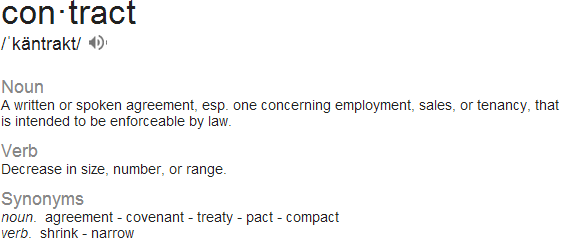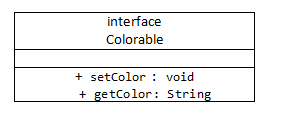Contract:
Often, an API is referred as a framework. We will consider a contract as an agreement that requires a developer to comply with the specification of an Application Programming Interface (API). As per English dictionary meaning of contract;

When using contracts, the developer is required to comply with the rules defined in the framework. This includes issues like method names, number of parameters, and so on. In short, standards are created to facilitate best practices for coding.
Enforcement is vital because it is always possible for a developer to breach the contract. But in the absence of a contract, a rough developer could decide to reinvent the wheel and write her own code rather than use the specification provided by the framework. In Java and the .NET languages, there are two ways to implement contracts are to use abstract classes and interfaces.
Abstract Classes:
One way to implement contract is via an abstract class. An abstract class is a class that contains one or more methods that do not have any implementation. Since every class is responsible for its own action but in this case, there are some methods which have no implementation thus they are abstract and that is why you cannot instantiate this class. Hence ‘abstract class cannot be instantiated’.
Let’s try to understand with an example. If I ask you to calculate an area, the first question you will be asking area of what? Circle or triangle or other. So the ‘CalculateArea’ is an abstract but area of circle or triangle not. We can implement ‘calculateArea’ for circle and triangle separately.
We will try to understand using UML diagrams;
This reflects the true polymorphic system. Any class using this Circle can use draw method and implement differently and get different result set. Let’s see in the form of code.
[sourcecode language=”java”]
public abstract class Area {
public abstract double CaluclateArea();// no implementation for an abstract method
}
[/sourcecode]
Note that this class does not provide any implementation for CaluclateArea method which makes this class abstract. There are two reasons it should be abstract, the first Area does not know what kind of area I am going to calculate and;
Second, we want a subclass of this base class to provide an implementation. i.e.;
[sourcecode language=”java”]
public class Circle extends Area {
double radius = 2.0;
double PI=3.14;
@Override
public double CaluclateArea() {
return PI*(radius * radius);
}
}
[/sourcecode]
To calculate Area of a triangle you can use as follows.
[sourcecode language=”java”]
public class Triangle extends Area{
double base = 2;
double height =4;
@Override
public double CaluclateArea() {
return (base * height)/2;
}
}
[/sourcecode]
If you ‘extends’ Area in Circle class and do not implement CalcualteArea method then the code will not compile and ask you to override and implement this method.
Though the concept of an abstract class is all around abstract method, there is nothing stopping Area from actually providing some concrete methods with complete implementation. Which is common to all subclasses. Just make sure if you have abstract methods in abstract class then you have to override and implement abstract method in a subclass. If you do not implement all abstract methods then the base class should be abstract.
- Remember
An abstract class is classified as strict inheritance, means is-a relationship works as opposed to an interface that is a has-a relationship which we will talk about in the next topic.
Interface
I am sure you must want to ask a question that if we have an abstract class that can provide the same functionality as an interface then why we need at the very first point.
Java and .NET do not provide multiple inheritances like C++. Java and .NET classes can inherit only one class so we can implement a number of interfaces.
Try to understand interface by UML diagram;
Note that in UML diagram Nameable is identified as an interface which distinguishes it from class. It has two methods GetColor() and SetColor ().
[sourcecode language=”java”]
public interface Colorable {
String getColor();
void(String colorName);
}
[/sourcecode]
In the above code, notice that Colorable is not declared as a class but as an interface. Thus, both methods, getColor() and setColor(), are considered abstract and there should be no implementation of any method in the interface. You can point some difference between interface and abstract class.
- An abstract class can have one or more abstract methods and methods with implementation while interface provides no implementation at all.
- Subclass extends an abstract class but implements the interface.
- Subclasses have to implement all methods of interface else give compiler error while you may or may not implement all abstract methods from abstract classes. In case if you are not implementing all method, you need to make a subclass as an abstract class using abstract keyword.


